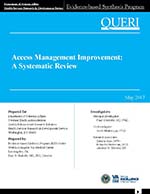
Principal Investigator:
Paul Shekelle, MD, PhD
Co-Investigator:
Isomi Miake-Lye, PhD
Research Associates:
Selene Mak, MPH;
Roberta Shanman, MLS;
Jessica M. Beroes, BSS
Download PDF: Complete Report, Abstract, Report, Appendices
Timely access to care is one of the fundamental characteristics of a health system.1 Access to primary care is important since primary care both diagnoses and treats most common conditions and also acts as the gateway, in systems like VA, to other types of care.
Providing access to care is a struggle for almost all health systems. VA is committed to improving access to primary care without the need to add substantial additional resources. An earlier ESP review from 2011 focuses on interventions to improve Veterans access to care. Among the topics considered were opening new Community-based Outpatient clinics, integrating mental health care into primary care, expanding the use of telehealth, reducing co-payments, etcetera. VA has made some policy changes based on these findings. More recently, the Institute of Medicine released a report, commissioned by VA, entitled Transforming Health Care Scheduling and Access: Getting to Now. This report noted that, while timely access was likely a problem nationwide, there is a lack of evidence to provide setting-specific guidance on what constitutes timely care. Nevertheless, the report concluded that despite deficiencies there are enough data to conclude that several basic principles be followed to improve access to care: matching supply to demand, immediate engagement of patient's needs, patient preference on the timing and nature of care, need-tailored care, surge contingencies, and continuous assessment of changing circumstances.
In addition to these efforts, there is interest in the active management of primary care access as a means to increase Veterans access. Primary care access management involves the consideration of a lot of interacting system parts and goals, including continuity, team roles, and management structures. VA requested this systematic review regarding the evidence about primary care access management strategies to better understand what populations and interventions are being studied and what are the measures used of definitions of intervention success.
Key Question 1: What definitions and measures of intervention success are used, and what evidence supports use of these definitions and measures?
Key Question 2: What samples or populations of patients are studied, including eligibility criteria?
Key Question 3: What are the salient characteristics of local and organizational contexts studied?
Key Question 4: What are the key features of successful (and unsuccessful) interventions for organizational management of access?
Key Question 5: Are relevant, tested tools, toolkits, or other detailed material available from successful organizational interventions?
Systematic Review: Access Management Improvement (Management Brief)